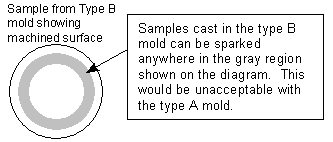Last updated on February 15th, 2023 at 03:05 pm
Supplier Resources
Review Best Practices
ASTM E716 Standard
Safety
The ASTM E716 standard describes best practices for obtaining representative samples for quantometer analysis. Please be aware of the safety disclaimer in section 1.3 of the ASTM E716 standard. It is the responsibility of the producing plant to ensure employee safety.
Review the entire standard with special emphasis on the following sections:
- 1. Scope, Safety
3. Summary of Practices
4. Significance of Use - 5.1 Ladle
5.2 Sample Molds
5.2.2 Type B - 5.3 Lathe
5.4 Tool Bits
7.1.1 Chill-Cast disk by Molds A or B
Section 5.2 discusses the significant benefits of using the "Type B" center pour mold. See the drawing below. This mold produces a sample that can be analyzed along a band just inside its circumference after proper machining.
Machined Samples
Machined samples sent to Logan must be between 7.0 - 11.2 mm (0.276-0.440 in) thick and 57-63mm (2.244-2.480 in) in diameter. Original sample thickness should be between 9.0-13.0 mm (0.354 - 0.512 in). Producing plants should use the ASTM type B mold.
Section 7.1.1 discusses the importance of machining to the correct depth in the sample. Machining off 14 to 22% of the original sample thickness presents a surface that will provide a representative chemistry (depending on the analytical capability of the spectrometer) of the bulk metal. Simple studies have shown that machining from the sprue side provides analysis less susceptible to mold and metal temperature.
Each producing plant must develop best practices so that the chemistry provided to Logan accurately represents the bulk metal chemistry. Chemical samples MUST be from the heat shipped. Each plant must ensure that enough samples are taken at casting time so that a sample is available for each heat shipped. Substituting a sample from a heat with a similar chemistry us unacceptable. A piece or corner cut from an ingot or sow is not an acceptable chemical sample.
additional Resources
Reference Materials
Samples / Sampling / Laboratory Practice
Below there are some pdf or Excel files that contain great training or reference materials. One of the most important sections illustrates why sample depth of cut is very important. The best example is Magnesium (Mg) segregation in 5182 alloy. Segregation occurs for all elements to some degree in most alloys. Machining the sprue side of the sample has been found to be the best. Consistent depth of cut to the correct depth is critical for obtaining representative chemistry of the melt.
- Magnesium variation through sample
Sample Thickness Gauge - Spark Location & Quantity
Alloy Check - 2 page description - Alloy Check Spread Sheet
Sample Quality, Chemistry & Chemical Analysis
If you have any questions about alloy checks or any other best practice please contact Miles.Propp@logan-aluminum.com

